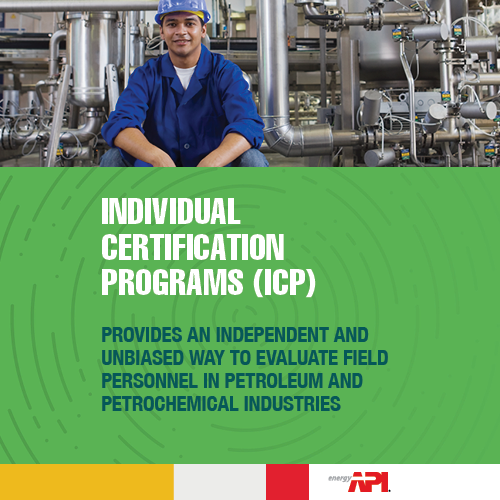Uniform or Localized Loss of Thickness
Amine Corrosion
Amine Corrosion occurs on carbon steel in amine treating processes. It is not caused by the amine itself, but rather as a result of dissolved acid gases (CO2 and H2S), amine degradation products, Heat Stable Amine Salts, and other contaminants. This damage mechanism can appear as either general uniform thinning, localized corrosion, or localized underdeposit attack.
Ammonium Bisulfide Corrosion (Alkaline Sour Water)
This type of corrosion occurs in hydroprocessing reactor effluent streams and in units handling alkaline sour water. Carbon steels are less resistant than 300 Series and duplex stainless steels, aluminum alloys, and nickel base alloys. The more ammonium bisulfide (NH4HS), H2S partial pressure, velocity, the more prone to Ammonium Bisulfide Corrosion a metal will be. Additional critical factors that increase the likelihood of this corrosion are pH, temperature, and flow distribution.
Ammonium Chloride Corrosion
When ammonia or amine chloride salts are present in a process stream, Ammonium Chloride Corrosion may occur. The following units and equipment are affected:
Crude Tower Overheads (tower tops, top trays, overhead piping, exchangers, and top pumparound streams)
- Hydroprocessing (reactor effluent streams)
- Catalytic Reforming (reactor effluent streams and the H2 recycle system)
- FCCU and Coker (fractionator overheads and top pumparounds)
Aqueous Organic Acid Corrosion
Crude oil may contain some organic compounds that can decompose in the crude furnace to form organic acids which condense in distillation tower overhead systems. These acids may lead to this type of corrosion.
All carbon steels are affected; most other alloys that are typically used in crude tower overhead systems are generally not affected.
Aqueous Organic Acid Corrosion in crude unit overhead systems can be minimized with the injection of a chemical neutralizing additive. However, frequent changes in crude blends must be paid attention to as they will require different types or amounts of neutralizers.
Filming amines can also be used to prevent this type of corrosion so long as the selected filming amine does not react with the organic acid. Filming amines are not as effective as neutralization.
And finally, as with many other types of corrosion, upgrading to corrosion-resistant alloys can prevent this type of corrosion.
Atmospheric Corrosion
Atmospheric Corrosion refers to corrosion that affects equipment that is not insulated and is exposed to moisture associated with atmospheric conditions such as rain, condensation from humidity, marine spray, cooling tower mist, industrial pollutants, etc.
Equipment located in dry or arid environments tend to have lower Atmospheric Corrosion rates (<1 mpy) than equipment found in marine environments (reaching up to 20 mpy).
As opposed to Corrosion Under Insulation, Atmospheric Corrosion is not hidden underneath insulation materials and can be found with visual inspection. Furthermore, if an equipment painting program is in place and up-to-date, the corrosion becomes even easier to find visually.
Boiler Water Condensate Corrosion
Boiler Water Condensate Corrosion occurs in boiler systems and condensate return pipings. It primarily affects Carbon Steels, as well as some low alloy steels, 300 Series SS, and copper based alloys.
This type of corrosion is usually the result of dissolved oxygen and carbon dioxide. Critical factors are the concentration of dissolved gas, pH, temperature, quality of the feedwater, and the specific feedwater treating system.
If the treatment system is effective, then a layer of iron oxide (magnetite) will provide the protection needed to minimize boiler corrosion. If the treatment is not effective or the quality varies from time to time then pitting type corrosion can occur in the entire front end of the boiler, including the treating system, deaerator, feed water lines, pumps, and preheat coils.
Higher pressure and temperature boiler systems tend to be more difficult to control to the specifications required for minimizing this type of corrosion. Chemical treatment for scale and deposit control must be tuned to coordinate with the oxygen scavenger (typically sodium sulfite or hydrazine) and tuned for the specific water quality and feedwater treating system. Routine water analysis is the best monitoring tool to make sure that treatment systems are functioning properly.
Caustic Corrosion
Caustic Corrosion is caused by the concentration of caustic or alkaline salts that usually occur under evaporative or high heat transfer conditions. Carbon steels, low alloy steels, and 300 Series steels are primarily affected.
The largest contributing factor to this type of corrosion is, as the name implies, the presence of caustic (NaOH or KOH).
As with many other types of corrosion, the best prevention/mitigation strategies are those that involve proper design.
CO2 Corrosion
Carbon dioxide (CO2) corrosion is most typically found in boiler condensate return systems that are not adequately treated with corrosion inhibitors (typically amines). Dissolved CO2 in condensate forms carbonic acid (H2CO3) which corrodes steels and low alloys to form an iron carbonate scale.
Mitigation/prevention of this damage mechanism involves:
- Using corrosion inhibitors
- Using neutralizers (amines) to increase the pH level of condensate above 6
- Using 300 Series Stainless Steel
Water analysis is the best way to detect condensate problems that may lead to leaks in condensate return systems. Radiography or ultrasonic thickness measurements on the bottom of condensate piping and on the back side of elbows or other areas of higher velocity and/or turbulence may also detect localized thinning typical of condensate corrosion.
Cooling Water Corrosion
Cooling Water (CW) Corrosion is caused by dissolved salts, gasses, organic compounds, or microbiological activity in water-cooled heat exchangers and cooling towers. It is one of the oldest forms of corrosion in the refining industry, yet it still poses challenges.
Cooling water corrosion and fouling are closely related and should be considered together. Critical factors in controlling both include: process and CW temperatures, heat flux, water velocity, type and quality of water (salt, brackish, fresh) and type of cooling system. Increasing process side temperatures or cooling water outlet temperatures typically will increase corrosion and fouling rates. Generally, if the process side temperature is above 140F (60C), then there’s a potential for scaling on the water side. With very few exceptions, the CW needs to be on the tube side to minimize corrosion and fouling. Fluid velocity in the tubes needs to be high enough to avoid dropping out deposits (typically ~3+fps) and low enough to avoid erosion-corrosion problems.
Corrosion in CW exchangers can manifest itself as general thinning, pitting, stress corrosion cracking and microbiologically induced corrosion. Electric resistance welded tubes will sometimes suffer localized weld attack, especially if the CW quality is less than desirable.
Cooling water corrosion and fouling can be prevented by proper design, operation, and chemical treatment of cooling water systems.
Corrosion Under Insulation
Corrosion Under Insulation (CUI) is one of the most well-known phenomena in the process industries, and yet it still makes up an inordinately large percentage of global maintenance expenditures. CUI is a subject that is well-researched and understood; extensive studies have been commissioned to determine the causes, effects, prevention, and mitigation of CUI.
CUI is corrosion that occurs due to the presence of moisture on the external surface of insulated or fireproofed equipment.
Any insulated piping or equipment is susceptible to CUI under the right conditions. Some examples of situations that may give rise to CUI are:
- A facility being location: regions with high annual rainfall or humid conditions are more prone to CUI than cooler, drier regions.
- Poor design or installation may allow water to become trapped.
- Inadequate design of insulation systems or improper selection of insulation types.
Numerous mitigation and inspection approaches have been studied and recommended, and are outside the scope of this summary. Refer to API RP 583, Corrosion Under Insulation and Fireproofing, for a thorough reference on the design, maintenance, inspection, and mitigation practices for equipment that is subject to CUI.
Image Gallery
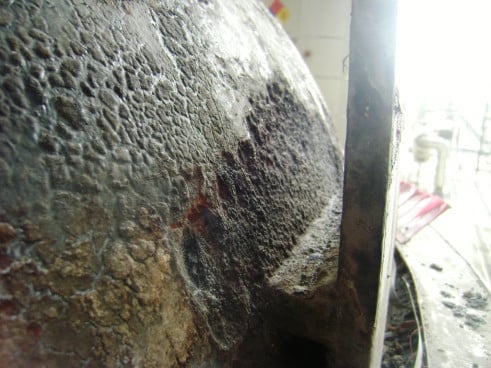
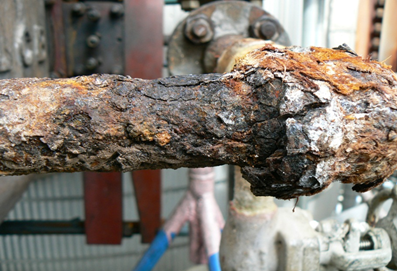
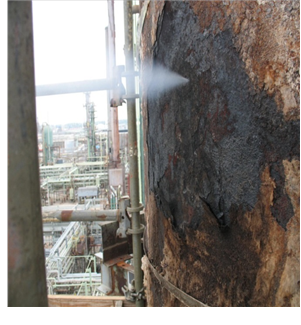
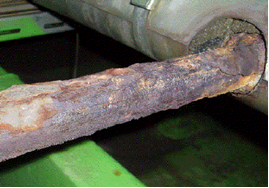
Dealloying
Dealloying, as the name implies, is corrosion that selectively removes specific elements from an alloy. It may also be referred to by the element removed (e.g. dezincification or dealuminification).
Alloys that are most commonly affected are copper alloys (brass, bronze, tin), Alloy 400, and cast iron (refer to Graphitic Corrosion).
Dealloying of these alloys is influenced by temperature, degree of aeration, pH, and time, although it is difficult to pinpoint exact conditions for each alloy. The following table, found in API RP 571, provides common examples of where dealloying has been found:
| Alloy | Environment | Element Removed |
| Brasses (>15% Zn) * | Many waters, especially stagnant conds. | Zinc (dezincification) |
| Gray Cast Iron | Soils, many waters | Iron (graphitic corrosion) |
| Aluminum bronze (primarily w/> 8% Al) | HF acid, acids w/chloride ions, seawater | Aluminum (dealuminification) |
| Silicon bronzes | High-temp steam and acidic species | Silicon (desiliconification) |
| Tin bronzes | Hot brine or steam | Tin (destannification) |
| Copper nickels (70-30) | High heat flux and low water velocity | Nickel (denickelification) |
| Monel | Hydrofluoric and other acids | Nickel (denickelification) |
| * The extent of dezincification increases with increasing zinc content. | ||
API RP 571 Table 4-7 – Combinations of Alloys and Environment Subject to Dealloying.
Flue-Gas Dew-Point Corrosion
Most flue gases produced by the combustion of fuels contain contaminants that can condense into sulfuric, sulfurous, or hydrochloric acid droplets. Flue Gas Dew Point Corrosion occurs when these aggressive acids condense on carbon and stainless steels in convection sections, flue ducts, and stacks. The amount of contaminants in the fuel is directly correlated with the concentration of the acid droplets, and therefore with the degree of corrosion.
There are several ways in which flue gas dew point corrosion can be avoided. More resistant materials can be used in the construction of flues, which can prevent corrosion. Also, limiting the number of contaminants in heater and boiler fuels is another good way to prevent corrosion from occurring. Although, it should be noted that the latter method is far more difficult to accomplish since most fuels contain sulfur compounds and some are contaminated with chlorides. Another way to prevent corrosion is to maintain the surface metal temperatures of exposed equipment above the dew point. it is possible to protect cooler surfaces by applying a coating that is resistant to the acidic condensate and will withstand the temperatures to which it is exposed.
Inspection of this type of corrosion involves (1) UT for wall thickness measurements to monitor wastage in economizer tubes, and (2) VT and PT to detect stress corrosion cracking of 300 Series SS.
Galvanic Corrosion
Galvanic Corrosion refers to the accelerated corrosion of one metal when in contact with another in a suitable electrolyte such as a moist or aqueous environment. All metals, with the exception of the most noble, are affected. In order for galvanic corrosion to occur, the following three conditions must be met:
- An electrolyte (a fluid that can conduct a current) must be present.
- Two different metals (known as the anode and the cathode) are in contact with the electrolyte.
- An electrical connection must exist between the anode and cathode.
The cathode is protected by sacrificial corrosion of the more active material (the anode). The anode corrodes faster than it would if it were not connected to the cathode through an electrolyte. If there is a large ratio of anode to cathode area, the cathode will effectively be protected and the anode may not corrode at all. Inversely, a small anode area and a large cathode area will result in rapid corrosion.
Prevention of galvanic corrosion is achieved through proper design. Coatings may also be helpful, but the more noble material should be coated.
Note: galvanic corrosion can also serve as a benefit when used purposefully – cathodic protection with sacrificial anodes provides corrosion protection of one metal by the preferential corrosion of another.
Graphitic Corrosion
Graphitic Corrosion is a form of dealloying that affects cast iron. Cast iron is comprised of graphite and iron; over a long period of exposure to low pH and stagnant conditions, the iron matrix of the cast iron is corroded, leaving only the porous graphite.
This damage mechanism can occur in the presence of soft water, salt water, mine water, dilute acids, and in underground piping and boiler feedwater equipment.
Damage caused by graphitic corrosion can be general or localized. It may not be noticeable upon visual inspection, but damaged areas will be soft and easily gouged with hand tools.
High Temp H2/H2S Corrosion
High Temperature H2/H2S Corrosion is a form of high temperature sulfidation that occurs in piping and equipment in units where high temperature H2/H2S streams are found. Such units include hydroprocessing units like desulfurizers, hydrotreaters and hydrocracking units.
The major factors affecting this damage mechanism are temperature, the presence of hydrogen, the concentration of H2S, and the alloy composition.
It can be prevented with proper materials selection – alloys with high chromium content minimize the damage. More specifically, the 300 Series SS (304L, 316L, 321, and 347) are highly resistant.
Hydrochloric Acid (HCl) Corrosion
Hydrochloric Acid (HCl) Corrosion is a significant problem in many refining and chemical process units, and often the materials solution to HCl corrosion is rather expensive, since the lower cost, more available alloys are usually not resistant to most concentrations of HCl. Typically process unit construction materials are chosen to resist HCl when the designers know where HCl will be present in the process, and at what temperature and concentration. The trouble comes when low pH HCl fluids show up where they were not expected or process changes occur causing unexpected HCl corrosion.
In the refining industry, the most common reason for HCl corrosion is dew point formation in the overhead of distillation towers. Most crudes contain inorganic salts that give rise to dew point HCl corrosion, and while effective desalting removes the vast majority of these salts (thus reducing overhead corrosion), the chlorides from those salts that are not removed often end up in the overhead piping, exchangers and accumulator vessels as low pH corrosive water solutions. Because of the mechanics/chemistry of dew point corrosion, the point where the dew point first occurs in the overhead steams is normally the most corrosive and lowest pH. If that point keeps shifting upstream or downstream (because of process variations) from where it was expected by the plant designers, then unexpected leaks can occur.
A similar phenomenon can occur at various mix points in process streams where chloride contaminated streams are mixed with lower temperature, wet process streams causing aggressive corrosion with hydrodynamic effects at the mix point and just downstream of it. Another fairly common source of corrosion from chlorides occurs in cat reforming units where chlorides are stripped from the catalyst and then migrate downstream in recycle hydrogen streams. If chloride beds/ treaters are not present or not maintained, then excessive chlorides can break through and cause corrosion wherever the dew point is reached downstream.
The refining industry has experienced a number of cases of severe corrosion from organic chloride contamination of process crudes. These organic chlorides are not effectively removed during normal desalting and often migrate downstream to naphtha hydrotreaters (NHT), where they hydrolyze into low pH streams that can cause corrosion rates into the 3-4 digit range, and leaks in equipment within a very short period of time. Unfortunately, these organic chlorides are not easily detected and are not revealed in typical crude assays. But there are effective means to test for them and to monitor wash water pH in NHT streams.
Prevention of HCl failures involves knowledge of where the low pH solutions are likely to exist and selection of a number of potential mitigation strategies. These strategies include choosing the right alloys to resist HCl corrosion, proper neutralization and/or inhibitor injection, avoidance of oxygenates that can cause corrosion of otherwise resistant high alloy materials, and installation and maintenance of wash water systems and monitoring pH of water steams.
HCl corrosion can be both general and highly localized depending upon where a dew point may be forming, where low pH solutions collect and the presence of hydrodynamic effects.
Hydrofluoric (HF) Acid Corrosion
Hydrofluoric Alkylation (“HF Alky”) Units are usually carefully controlled in order to avoid potential for a toxic hydrofluoric acid cloud after a leak. That said, HF Alky Units also can have problems with process control that results in wet acid carryover into carbon steel sections of the plant, which were never intended to be exposed to HFA, resulting in corrosion and leaks. Whenever the temperature of the acid phase exceeds 150 F or water content of the acid exceeds 3% (or some combination thereof), there is the likelihood of higher corrosion rates on carbon steel equipment. In areas prone to corrosion on carbon steel, Alloy 400 is widely used with success, if oxygenates are minimized.
Carbon steel areas prone to corrosion include flange faces, deadlegs, overhead systems, and some heat exchanger bundles. One of the interesting aspects of HF Acid Corrosion on carbon steel is that corrosion rates can vary considerably depending on the residual elements content of the steel. Some evidence exists that the total % of Cu, Ni, and Cr need to be below 0.20% in order to avoid accelerated corrosion of carbon steel in specific parts of the plant.
Refer to API RP 751 Safe Operation of HFA Alkylation Units for a more complete reference on this damage mechanism.
Microbiologically Induced Corrosion (MIC)
Microbiologically Induced Corrosion (MIC) is caused by biological growth such as bacteria, algae, or fungi, in water under low flow or stagnant conditions. It occurs in cooling water systems, piping, vessels, and storage tank bottoms where the conditions are conducive to it.
The following excerpt from A Framework for Conducting Analysis of Microbiologically Influenced Corrosion Failures goes into further detail:
On wetted surfaces, microorganisms typically exist in a diverse biofilm that consists of extracellular polymeric substances (EPS), various types of cells, and organic and inorganic material. Biofilms formed by microorganisms create a microenvironment on the metal surface that can differ significantly from the overall environment, leading to local differences in electrochemical potential resulting in corrosion. Microbial activities in biofilms can also facilitate corrosion by producing corrosive metabolites (acids, elemental sulfur), changing the nature or kinetics of rate controlling reactions, forming mineral scales, and direct uptake of electrons from the steel surface.
Microorganisms and their activities are affected by many environmental factors, including most prominently, temperature, salinity, oxygen concentration, pH, and availability of nutrient compounds. Although most microorganisms can exist over a range of these environmental conditions, they commonly have a set of conditions at which growth is optimal. When conditions are unfavorable, cells may become dormant or die, or transition to a spore form that can last a long time until conditions once again become favorable for growth.
MIC manifests itself as pits that sometimes have subsurface “caverns” that are larger than the pitted opening to the surface.
Naphthenic Acid Corrosion
Naphthenic Acid Corrosion (NAC) is associated with dry hydrocarbon streams (no water phase). There are a variety of organic acids associated with naphthenic acids in different crudes, and each can have a different impact on the actual corrosion rates experienced. Though sulfur in crude promotes the passivity and thus has an inhibiting effect on NAC, naphthenic acids remove the protective sulfide scales, and typically result in a very localized type of corrosion, which is difficult to find during external examinations of equipment. And though NAC damage is typified by dozens of small localized “pock marks” and grooving type corrosion surrounded by full thickness material, some lower alloys can corrode by general thinning. Velocity and turbulence are big issues with regard to NAC rates, including the flash zones of VFU’s, areas of two phase flow, weld profile discontinuities, piping components, thermowells and pumps. Typically, the higher the temperature of the hydrocarbon stream (up to 800 F [427 C]), the more severe the NAC will be, up until the streams move into cat crackers and hydroprocess units where the organic acids are destroyed.
Mitigation of the NAC is typically done in one of two ways or a combination of them. Upgrading construction materials with increasing amounts of Molybdenum is most effective, with type 316 and 317 stainless steels offering good resistance under most circumstances where low alloy steels no longer offer cost effective resistance. However, when conditions are particularly severe for NAC, upgrading to 6% Mo alloys has provided resistance. The other main mitigation method is crude and process cut blending to stay below a certain preset TAN in the crude or process cut. Some companies have also tried NAC inhibitors. All of the known mitigation strategies are pulled together in a model called CORAS, offered by Shell Global Solutions to help find the most cost effective way to process high TAN crudes.
Phenol (Carbolic Acid) Corrosion
When phenol is used as a solvent in plants to remove aromatic compounds from lubricating oil feedstocks, Phenol Corrosion can occur. Materials affected, in order of increasing resistance, are carbon steel, 304L, 316L, and Alloy C276. This damage mechanism most commonly occurs in phenol extraction facilities in lube plants.
As with many other damage mechanisms, the best prevention is to proactively select proper materials and control of phenol solvent chemistry.
UT and RT can be used to monitor for thickness losses, and ER corrosion probes and corrosion coupons have been used for corrosion monitoring.
Phosphoric Acid Corrosion
Corrosion from phosphoric acid is an issue that affects only a few processes in the refining industry. It is largely associated with polymerization units using phosphoric acid as a catalyst. Dry phosphoric acid catalyst is not corrosive to carbon steel but that changes dramatically when free water is present. For nearly all acidic corrosion, water content and temperatures are keys to understanding how aggressive the corrosion is likely to be. Wet phosphoric acid can corrode carbon steel at thousands of mils per year. Where water is present, upgrading to 304L, 316L, or Alloy 20 may be necessary largely depending on temperature. Corrosion can often be found in dead zones and crevices where wet acid can drop out.
Soil Corrosion
Soil corrosion (also “underground corrosion”) is, as the name suggests, corrosion caused by metals that are exposed to soils. It is well known and documented since so many pipes and pipelines are buried underground, and nearly all storage tanks rest on the soil. Soil corrosion rates can range from very low to fairly aggressive, depending on the type of soil, the amount of moisture, soil contamination, soil resistivity, drainage, and oxygen content.
Properly selected and applied coatings are key to soil corrosion control. A combination of a well-designed and maintained Cathodic Protection system, alongside good coatings, is the best way to control soil corrosion.
API 570, Piping Inspection Code, has an entire section devoted to the inspection of buried piping.
Sour Water Corrosion (Acidic)
Acidic sour water which contains H2S and a pH between 4.5 and 7.0 can result in Acidic Sour Water Corrosion. It is a concern in FCCU overhead systems and coker gas fractionation plants with high levels of H2S and low NH3 levels.
This damage mechanism primarily affects Carbon Steel, Stainless steel, copper, and nickel-based alloys are resistant.
Sulfuric Acid Corrosion
Sulfuric Acid Corrosion of carbon steel and other alloys occurs when sulfuric acid reacts with the iron in carbon steel to form ferrous sulfate (FeSO4). In the refining industry, the most common place to experience this damage mechanism is in the sulfuric acid alkylation units where process control or water contents of acids deviates from design operation.

